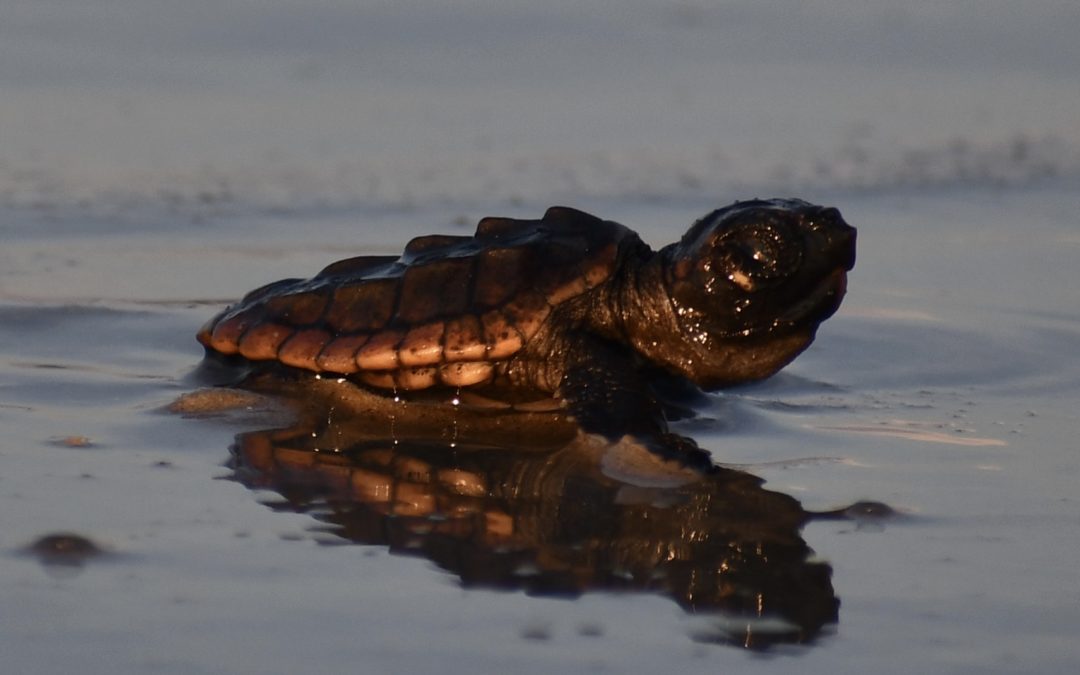By Ben Ranelli, Seasonal Biological Technician on Ocracoke Island
As a biotech, there is hardly a more rewarding sight than a swell of sea turtle hatchling tracks left behind from their oceanward journey. Knowing the effort to protect their nests has given each hatchling the best possible chance of survival can be deeply fulfilling, but even after a successful hatch there is yet more work to be done. Inside the nest cavity, there is valuable information still to collect about the turtles’ biology and the best strategies for Cape Hatteras National Seashore to protect their species. Nest excavation, or digging into a sea turtle nest to study its contents, is the process that reveals the sometimes-surprising story of what happens in a sea turtle nest.
When are sea turtle nests excavated?
When a nest is excavated depends on when it hatches. Typically within 55-65 days of incubation, most nests experience a “boil” in which numerous hatchlings emerge from the nest all at once, relying on safety in numbers to avoid predators as they make their way to the ocean. After a boil, excavations are scheduled three days later to allow any remaining hatchlings the opportunity to emerge on their own. Alternatively, a nest may experience a “trickle” and a few turtles may emerge slowly over multiple nights. After a trickle, five days are given to allow additional time for a trickle to continue. In either case, high winds or the consistency of the sand may obscure hatchling tracks, making it impossible to determine if or when the hatchlings emerged. For such uncertain cases, excavations only take place after the eggs have been incubated for a total of 70 days to avoid unnecessarily disturbing any unhatched eggs that remain viable.
What is left in a sea turtle nest after the eggs hatch?
Ideally, a nest will be full of empty eggshells indicating that the young turtles successfully hatched and emerged from the nest. Despite being sheltered under the sand, both eggs and hatchlings still face daunting challenges from the surrounding environment and may not fare as well. Nests may contain eggs that failed to hatch because of developmental reasons, overwashes from high tides, or predation by animals like coyotes or ghost crabs. Even the roots of dune vegetation may grow through a nest, puncturing eggshells in their path. More optimistically, there may also be hatchlings still in the nest that did not emerge with their siblings but, with assistance, will still have a chance to thrive.
What happens to hatchling sea turtles still in the nest?
Live hatchlings that do not emerge on their own are kept in safe conditions until they can be released to the ocean, often in the evening, when they will not confront the intense heat of the day or as many predators. Without human intervention, there is a high likelihood that these remaining hatchlings would never emerge from the nest. In some instances, hatchlings encounter hard-packed sand impossible for them to dig through. Others may be buried under the eggshells or displaced sand left behind by their siblings who already emerged from the nest. Regardless of their circumstance, the assistance offered to the hatchlings otherwise left behind dramatically increases their probability of survival.
What data can be collected from unhatched eggs?
Any unhatched eggs are opened so the contents can be studied and classified based upon its stage of development. Undeveloped eggs lack any discernable sign of embryonic growth and contain only yolk; it is likely these eggs were either never fertilized or that a genetic anomaly occurred in the very beginning stages of development. Early-stage growth can be detected by examining the egg for a dark eyespot, one of the first organs to develop, and small patches of pink tissue. On the opposite end of the spectrum, turtles in late-stage development may look nearly identical to a fully hatched sea turtle and have absorbed most or all of their yolk. Excavations are also an opportunity to identify mutations that might have led to a halt in development. Missing flippers, malformed jaws, leucism (a condition similar to albinism that limits production of pigment), and even two-headed hatchlings have been recorded on the Seashore.
How do excavations inform science and management?
Nest excavations ultimately provide useful data on the success of Cape Hatteras’ sea turtle nests and whether current management techniques effectively promote their survival. Excavations can reveal threats to overall nest success, such as tidal overwash caused by hurricanes. By comparing the stage at which eggs stopped developing with flooding during major storms, specific storms can be pinpointed as the cause of nest loss. Once problems are identified, data from nest excavations help formulate solutions. In the case of extreme hurricane tides, hatch success rates calculated from excavation data also show which flood-prone stretches of beach are less suitable for turtle nests. Then, in future years, new turtle nests found along those stretches can be relocated to nearby sites more resistant to flooding. If the management solutions are effective, hatch success rates should increase after next summer’s excavations and the strategy for protecting sea turtle nests can continually improve. As new challenges like climate change compound the host of threats already facing endangered sea turtle species, digging deeper into their biology and environment with nest excavations will be more critical than ever in ensuring their survival.
About Ben
Ben Ranelli is a seasonal biological science technician working in the Ocracoke district of Cape Hatteras National Seashore. Originally from Connecticut, he began working for the National Park Service after previously conducting research at the University of Connecticut and the Smithsonian Conservation Biology Institute. Working with birds, mammals and turtles across forests, mountains and seashores, he has dedicated his time to understanding and sharing the incredible diversity of wildlife in the eastern United States.

